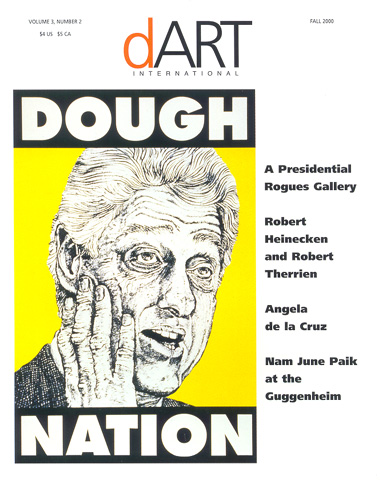
Politics in Ink on Paper
by Christopher Miles
While Los Angeles civic leaders and police have been hammering out plans to corral protestors during the 2000 Democratic Convention (if you read a bit of irony in that, you're not alone), the Center for the Study of Politi-cal Graphics has been organizing an exhibition of posters showing how impassioned individuals and groups have put into print their feelings about American presidents and presidential politics over the last four decades. Protest posters are among the most fleeting manifestations of free expression in contemporary culture because their politics and frequently anonymous authorship have tended to turn off interest from the art world, and because their of-the-moment quality and often precarious display locations contribute to a short life span. The center, a non-profit organization dedicated to collecting, preserving, documenting, and exhibiting "posters relating to historical and contemporary movements for peace and social justice," currently houses roughly 35,000 graphic works, a staggering number considering that the political poster didn't really come to life until the last few centuries, when individuals around the world became more brazen in their expression and printing technology became increasingly accessible.
A Presidential Rogues Gallery: Satirical Posters 1960s-Present was previewed on August 3 at the center's [Un]Convention 2000, where guests voted for their own ideal president from a list of living, dead, and imaginary figures nominated by a panel of artists, writers, entertainers, and activists. The exhibition then runs for one week only at Frumkin/Duval Gallery, concurrent with the Democratic Convention (August 13-20). Offerings include classics like an image of Ronald Reagan wearing cowboy garb and sporting a pistol (taken from one of the actor/president's movies), inscribed with the title, The Fascist Gun in the West, and a pairing of Richard Nixon's mug with the question, "Would you buy a used war from this man?" Democrats and Republicans alike are skewered and roasted in the exhibition, which also includes graphic indictments of LBJ and a more recent poster by artist Robbie Conal that combines the image of a dumbstruck Bill Clinton with a provocative play on words: Dough Nation.
Protest posters are difficult for art critics because their messages are unambiguous and obvious. After all, one of the great joys we have as viewers is the process of figuring out, making up, and assigning meaning, and one of the primary functions of my role as a critic is to revel in and, in my own way, exemplify that process. So what do we do with images and words that wear their politics on their sleeves? Aesthetic judgments seem beside the point, and as for the politics, well, you tend to either agree
or disagree, but that's about the politics, not the poster.
The problem I have in looking at art where the politics are all laid out for me is the same problem I would have were I a Roman citizen surrounded by church-guided religious art during the Baroque period. I can either agree or disagree, but that's about it. That said, however, I should point out that I love looking at Christian painting from the pre-Renaissance through the Baroque precisely because I can agree or disagree and then get wrapped up in examining how the artists went about trying to communicate ideas and beliefs that were fervent and undoubted -how narratives are structured, how emotion and drama are channeled, how images are combined and sometimes combined with words, and how subtle and not-so-subtle cues and clues are dropped here and there.
This is why protest posters and overt political art are fascinating: because they offer a glimpse into how people go about communicating things they deeply want to communicate unambiguously-something we don't seem to do too much anymore, whether it's about politics or anything else. These artists don't care if you like them, they don't aspire to be valued (though people might attempt to rarefy them), and one can hardly argue with the logic of their directness. After all, a protest poster that lacks a clear position makes about as much sense as an advertisement that encourages you to make up your own mind or a traffic signal that leaves it up to your best judgment. Some things simply are meant to be direct and to the point, and at a time when meaning is a matter of filtering and diffusion, it's eye-opening to examine the expressions of individuals who want to serve their messages straight up and without chasers. Moreover, while living in a multi-party system that for all practical purposes is a two-party system that lately feels more like a one-party system, it's good to be reminded that opposition is an option, and in an election year climate defined by a general sense of numbness, it's refreshing to be reminded of what it's like to feel emphatic.
|